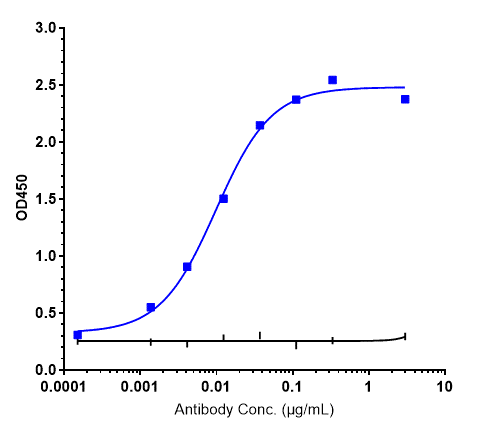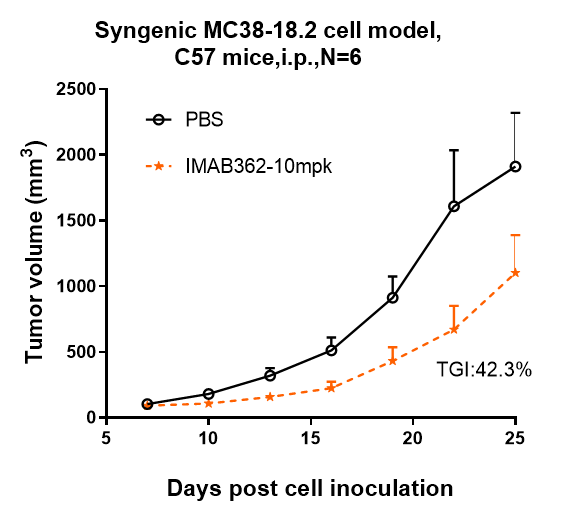Anti-CLDN18.2 Reference Antibody (zolbetuximab)
Recombinant Antibody
- SPECIFICATION
- CITATIONS
- PROTOCOLS
- BACKGROUND

Application
| FC, Kinetics, Animal Model |
|---|---|
| Primary Accession | P56856 |
| Reactivity | Human, Mouse |
| Clonality | Monoclonal |
| Isotype | IgG1 |
| Calculated MW | 150 KDa |
| Target/Specificity | CLDN18.2 |
|---|---|
| Endotoxin | < 0.001EU/ µg,determined by LAL method. |
| Conjugation | Unconjugated |
| Expression system | CHO Cell |
| Format | Purified monoclonal antibody supplied in PBS, pH6.0, without preservative.This antibody is purified through a protein A column. |
| Name | CLDN18 |
|---|---|
| Function | Involved in alveolar fluid homeostasis via regulation of alveolar epithelial tight junction composition and therefore ion transport and solute permeability, potentially via downstream regulation of the actin cytoskeleton organization and beta-2-adrenergic signaling (By similarity). Required for lung alveolarization and maintenance of the paracellular alveolar epithelial barrier (By similarity). Acts to maintain epithelial progenitor cell proliferation and organ size, via regulation of YAP1 localization away from the nucleus and thereby restriction of YAP1 target gene transcription (By similarity). Acts as a negative regulator of RANKL-induced osteoclast differentiation, potentially via relocation of TJP2/ZO-2 away from the nucleus, subsequently involved in bone resorption in response to calcium deficiency (By similarity). Mediates the osteoprotective effects of estrogen, potentially via acting downstream of estrogen signaling independently of RANKL signaling pathways (By similarity). |
| Cellular Location | Cell junction, tight junction {ECO:0000250|UniProtKB:P56857}. Cell membrane {ECO:0000250|UniProtKB:P56857}; Multi-pass membrane protein. Note=Localizes to tight junctions in epithelial cells {ECO:0000250|UniProtKB:P56857} [Isoform A2]: Cell junction, tight junction {ECO:0000250|UniProtKB:P56857}. Lateral cell membrane {ECO:0000250|UniProtKB:P56857} |
| Tissue Location | [Isoform A1]: Expression is restricted to the lung. |

Thousands of laboratories across the world have published research that depended on the performance of antibodies from Abcepta to advance their research. Check out links to articles that cite our products in major peer-reviewed journals, organized by research category.
info@abcepta.com, and receive a free "I Love Antibodies" mug.
Provided below are standard protocols that you may find useful for product applications.
If you have used an Abcepta product and would like to share how it has performed, please click on the "Submit Review" button and provide the requested information. Our staff will examine and post your review and contact you if needed.
If you have any additional inquiries please email technical services at tech@abcepta.com.













 Foundational characteristics of cancer include proliferation, angiogenesis, migration, evasion of apoptosis, and cellular immortality. Find key markers for these cellular processes and antibodies to detect them.
Foundational characteristics of cancer include proliferation, angiogenesis, migration, evasion of apoptosis, and cellular immortality. Find key markers for these cellular processes and antibodies to detect them. The SUMOplot™ Analysis Program predicts and scores sumoylation sites in your protein. SUMOylation is a post-translational modification involved in various cellular processes, such as nuclear-cytosolic transport, transcriptional regulation, apoptosis, protein stability, response to stress, and progression through the cell cycle.
The SUMOplot™ Analysis Program predicts and scores sumoylation sites in your protein. SUMOylation is a post-translational modification involved in various cellular processes, such as nuclear-cytosolic transport, transcriptional regulation, apoptosis, protein stability, response to stress, and progression through the cell cycle. The Autophagy Receptor Motif Plotter predicts and scores autophagy receptor binding sites in your protein. Identifying proteins connected to this pathway is critical to understanding the role of autophagy in physiological as well as pathological processes such as development, differentiation, neurodegenerative diseases, stress, infection, and cancer.
The Autophagy Receptor Motif Plotter predicts and scores autophagy receptor binding sites in your protein. Identifying proteins connected to this pathway is critical to understanding the role of autophagy in physiological as well as pathological processes such as development, differentiation, neurodegenerative diseases, stress, infection, and cancer.





